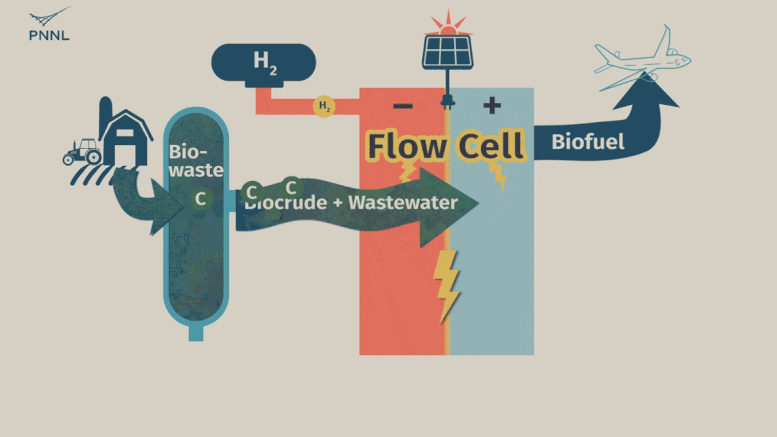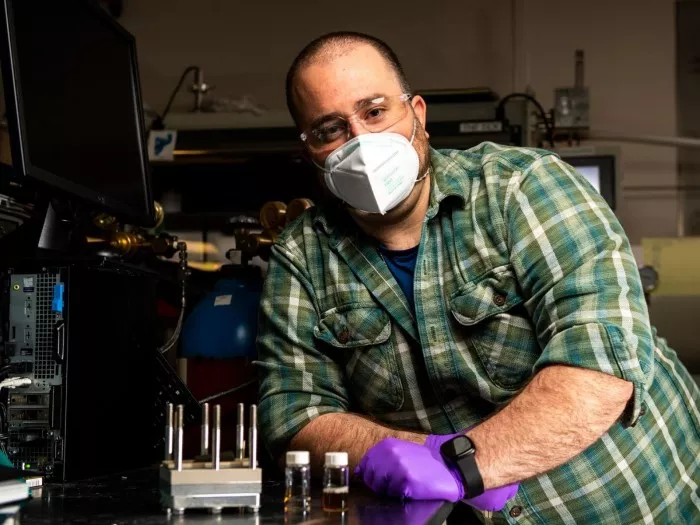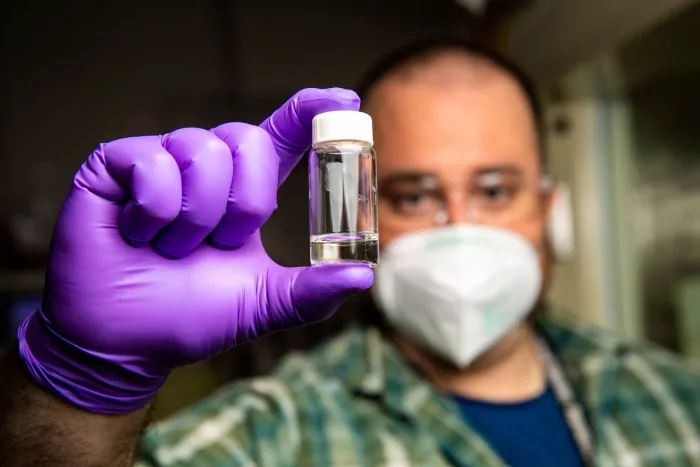The Holy Grail for biofuel researchers is to create a self-sustaining process that converts waste from sewage, food crops, algae and other renewable carbon sources into fuel while keeping waste carbon from entering our environment and water. Although much progress has been made in converting such waste into usable fuel, completing the cycle with clean energy has proved to be a difficult problem.

Now, a research team at the Northwest Pacific National Laboratory (PNNL) of the U.S. Department of energy has designed a system to complete this task. PNNL's electrocatalytic oxidation fuel recovery system converts previously considered unrecoverable and diluted "waste" carbon into valuable chemicals, while also producing useful hydrogen. Due to the use of renewable energy, the process is carbon neutral and may even be carbon negative.
The key to making all this work is an elegantly designed catalyst, which combines billions of infinitely small metal particles and current, and can accelerate energy conversion at room temperature and pressure.

Juan A. Lopez Ruiz, chemical engineer and project leader of PNNL, said: "the current method of treating bio crude oil requires high-pressure hydrogen, which is usually produced by natural gas. Our system can produce hydrogen by itself, and use excess renewable power to treat wastewater under conditions close to the atmosphere, so as to make it cheap to operate and possible to achieve carbon neutralization."
A hungry system
The research team tested the system in the laboratory with wastewater samples from industrial scale biomass conversion process, and did not find any loss of efficiency after more than 200 hours of continuous operation. The only constraint is that the team has run out of wastewater samples.
"It's a starving system," Lopez Ruiz said. "The reaction rate of the process is directly proportional to the amount of waste carbon you're trying to convert. If you have waste water circulating through it, it can run indefinitely."
According to Lopez Ruiz, the patent pending system solves several problems that have plagued efforts to make biomass an economically viable renewable energy source.
"We know how to turn biomass into fuel," Lopez Ruiz said. "But we are still trying to make this process energy efficient, economical and environmentally sustainable, especially on a small, distributed scale. This system operates on electricity, which can come from renewable resources. And it generates its own heat and fuel to keep it running. It has the potential to complete the energy recovery cycle."
Lopez Ruiz continued: "as the power grid begins to shift its energy sources to integrate more renewable energy sources. It is becoming more and more meaningful to rely on electricity to meet our energy needs. To this end, we have developed a process that uses electricity to convert carbon compounds in wastewater into useful products while removing impurities such as nitrogen and sulfur compounds."
Narrowing the energy gap
Hydrothermal liquefaction (HTL) is a very effective method to convert wet waste carbon into fuel. This process, in essence, reduces the time required to produce natural fossil fuels, which can convert wet biomass into energy intensive bio crude oil in a few hours rather than thousands of years. However, the process is incomplete, because the wastewater generated as part of the process needs to be further treated, so that it is convenient to obtain added value from what is originally a responsibility.
"We realize that the same (electro) chemical reaction that removes organic molecules from wastewater can also be used to directly lift bio crude oil at room temperature and atmospheric pressure," Lopez Ruiz said
This is where PNNL's new process works. Unrefined bio crude oil and wastewater can be directly input into the system from HTL output stream or other wet waste. PNNL process is composed of so-called flow tank. Wastewater and biological crude oil flow through the flow tank and encounter the charged environment generated by current.

A thin anodic foil coated with ruthenium oxide nanoparticles is called a positive ribbon. Here, the waste stream has undergone catalytic conversion, and the bio crude oil is converted into useful oil and paraffin. At the same time, water-soluble pollutants such as oxygen and nitrogen compounds are chemically transformed into nitrogen and oxygen, the normal components of the atmosphere. The wastewater from the system can be sent back to the HTL process after removing pollutants.
In the negative half of the mobile cell, the cathode, there are different reactions, which can make organic molecules hydrogenate or produce hydrogen, an emerging energy, which is regarded by mobile cell developers as a potential fuel source.
"We believe that the hydrogen by-product produced by this process is a net value-added. When collected and fed into the system as fuel, it can make the system operate with less energy input and may make it more economical and carbon neutral than current biomass conversion operations," Lopez Ruiz said.
The speed of chemical conversion provides an additional benefit to the system. Lopez Ruiz said,
In the rate comparison, they saw that the conversion rate obtained by electrochemical system under atmospheric conditions was more than 100 times that obtained by thermal system under medium hydrogen pressure and temperature.
Reduce the use of rare earth metals
An important disadvantage of many commercial technologies is their dependence on rare earth metals, sometimes referred to as platinum group metals. The global supply chain of these elements relies mainly on outdated extraction technologies, which are energy intensive, require large amounts of water and produce hazardous waste. According to the Department of energy, which makes U.S. supply a top priority, imports account for 100% of the country's supply of 14 of the 35 key materials and more than half of the other 17 materials.
The system solves this problem by using a unique method to deposit nanoparticles of metals responsible for chemical conversion. These particles have a large surface area and only need less metal to complete their work. "We found that the use of metal nanoparticles reduced metal content and improved electrochemical performance compared to metal films and foil," Lopez Ruiz said The precious metal required for this new catalyst is ruthenium in this case, which is 1 / 1000 of the precious metal usually required for similar processes. Specifically, the electrodes used in laboratory scale flow reactors contain about 5 to 15 mg of ruthenium, while similar reactors require about 10 g of platinum.
About those useless carbon compounds
The team also pointed out that the PNNL process can treat small water-soluble carbon compounds - by-products found in the wastewater of the current HTL process - and many other industrial processes. About a dozen of these small carbon compounds are difficult to treat in low concentration wastewater streams. So far, there is no cost-effective technology to deal with them. These short chain carbon compounds, such as propionic acid and butyric acid, can be converted into fuels in newly developed processes, such as ethane, propane, hexane and hydrogen.
The preliminary cost analysis shows that the power cost required to operate the system can be completely offset by operating at low voltage, which can use propane or butane to generate heat and sell the excess hydrogen generated.
Battelle, who manages and operates PNNL for the US federal government, has applied for a US patent for the electrochemical process. Cognitek management system (cognitek) is a global company that brings energy products and technical solutions to the market. It has obtained the license of this technology from PNNL. Cognitek will integrate PNNL's wastewater treatment technology into the patented biomass treatment system being developed and commercialized by cognitek and its strategic partners. Their goal is to produce biofuels, such as biodiesel and bio aviation fuel. In addition to the commercialization agreement, PNNL and cognitek will cooperate to expand the wastewater treatment reactor from laboratory scale to demonstration scale.
Michael gurin, CEO of cognitek, said: "we cognitek are excited about the opportunity to promote PNNL technology in combination with our core patents and patent pending decarbonization technology."
This technology, known as "clean and sustainable electrochemical treatment technology (cleanset)", can be licensed by other companies or companies or municipalities interested in specific industries such as municipal sewage treatment plants, dairy farms, breweries, chemical manufacturers and food and beverage manufacturers.